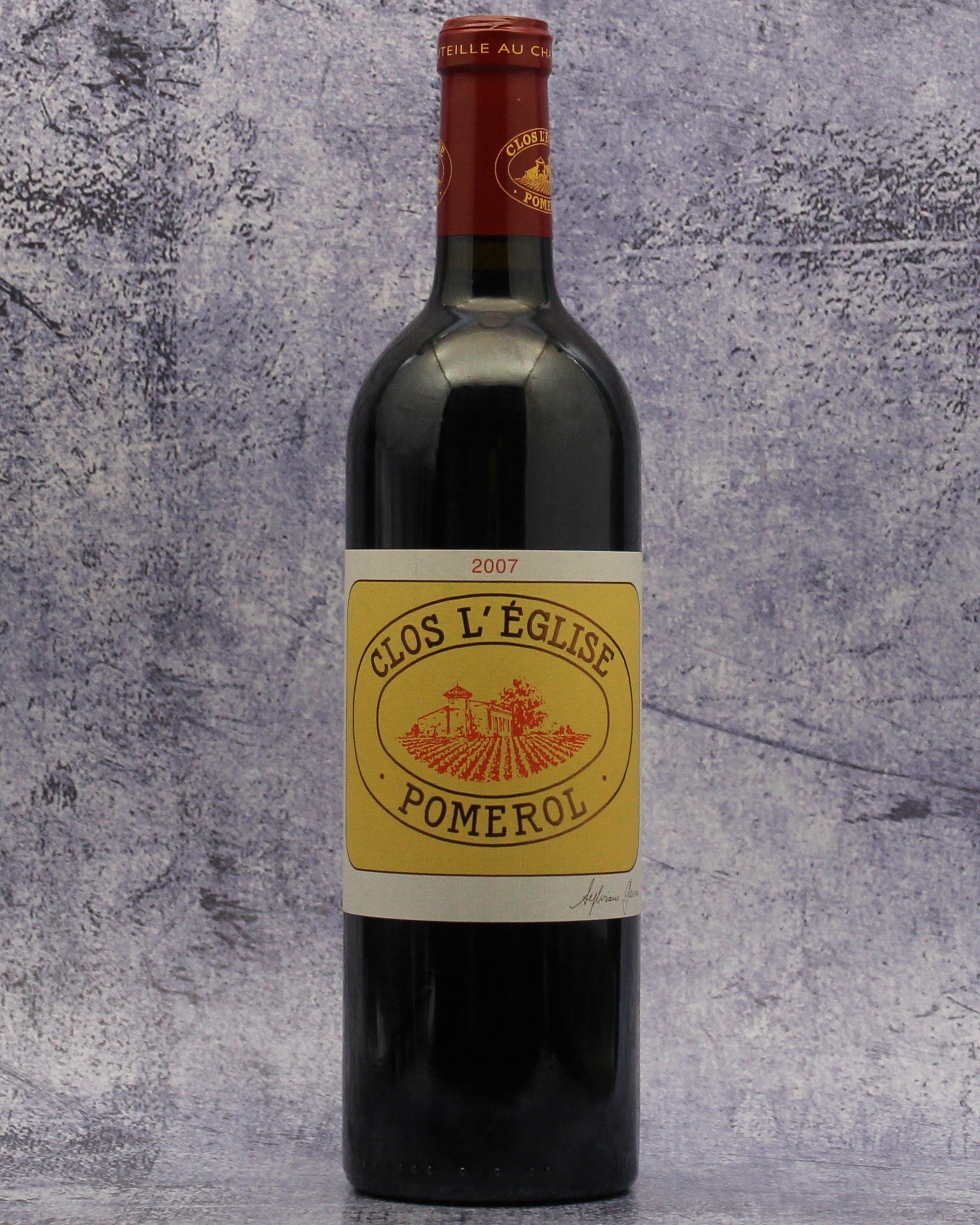Description
From: Pomerol, Bordeaux, France
Blend: 80% Merlot, 20% Cabernet Franc
Taste & Critical Acclaim: 94 James Suckling Review Date: 04/2018
This is a sensational 2007 with black-truffle, violet and dark-berry aromas. Medium to full body and firm, silky tannins. Balanced. Decadent.
91 Vinous Review Date: 07/2010
Full medium ruby. Almost decadent aromas of crushed dark raspberry, framboise and coffee. Chewy, lightly saline and wild, with impressive stuffing and a nicely restrained sweetness. This edge-free wine possesses solid structure without any impression of hardness. Finishes with lovely melting Pomerol tannins. (ST)
90 Wine Advocate Review Date: 06/2017
Tasted at the château, the 2007 Clos l'Eglise was a pleasant surprise with quite vigorous black cherry and bergamot scents, just a hint of black tea, certainly showing good intensity after ten years. The palate is medium-bodied with fine-grained tannin, fine backbone, a pinch of cracked black pepper on the entry with a solid, slightly austere but focused finish that is resolutely classic in style. I appreciate the "Pomerol-ness" of this Clos l'Eglise. Drink now and over the next 6-8 years. Tasted March 2017. (NM)
WS Wine Spectator Review Date: 03/2010
Blackberry, toasty oak and raspberry aromas follow through to a full body, with fine tannins and a lovely concentration. There's plenty of chewy, yet polished tannins. A little more in the midpalate would make this outstanding. Best after 2014.
About, via the Wine Cellar Insider. The estate of Clos L’Eglise is one of the older chateaux in Pomerol dating all the way back to the 18th century. That is also when the farmhouse that remains in use today was constructed. At the time, Chateau Clos L’Eglise was a larger estate. In fact, the property was in its formative years, part of the Gombaude Guillot estate.
Eventually, the vast estate was split in half. On one side of the street, you had Clos l’Eglise, which was owned by the Rouchut family.
Across the street sat Clos l’Eglise-Clinet, which was owned by the Mauleon family. In time, Clos l’Eglise Clinet eventually changed its name to Chateau lEglise Clinet which also simultaneously gave birth to what we know today as Clos L’Eglise. Interestingly, the estate is one of the few chateaux named Clos, without a walled-in vineyard. Clos is translated into the wall.
While the wines are now produced by the current owners, that was not always the case with Clos L’Eglise. At one point in time, the estate produced wines under a leasing arrangement held by the Rouchut family. That is of course not the case today.
Clos L’Eglise The Modern Age
The modern era of Clos L’Eglise begins in 1975 when the property and its wine-making facilities were completely redesigned and modernized by the Moreau family. The Moreau’s were well versed in Pomerol, as they were also the owners of Chateau Plince. The old, non-temperature-controlled wood tanks were replaced by stainless steel.
The vineyard was also expanded to its current size. Instead of buying more vines, the owners simply planted land that was still being used as a pasture. In those days, the property was planted with a much larger percentage of Cabernet Sauvignon at close to 20%. All the Cabernet Sauvignon vines were eventually ripped out and replaced by Merlot grapes.
The next step forward took place in early 1997 when the Right Bank estate was sold to Sylviane Garcin Cathiard by the Moreau family. If the Cathiard name sounds family, she is the sister of Daniel Cathiard, the owner of Chateau Smith Haut Lafitte, located in Pessac Leognan.
The sale set a new benchmark price for Pomerol when it sold for 12 million Euros! Today that price would be considered a steal. But prior to 2000, that was considered a massive sum of money for Pomerol.
Due to the aging state of the winery, additional funds were needed to replace the older concrete vats, and once again modernize the facilities. In fact, the first vintage of Clos L’Eglise made by the new owners was produced at one of their estates in Pessac Leognan, Haut Bergey.
Along with the aforementioned properties in Pessac Leognan, Helene Garcin also manages her two estates in St. Emilion, Chateau Barde Haut, and Chateau Poesia. Previously, she also managed their vineyards in Pessac Leognan, Branon, and Haut Bergey.
The family is also involved with vineyards in the Mendoza appellation of Argentina where they produce wine from 13 hectares of old vine, un-grafted Malbec and Cabernet Sauvignon, planted in 1935.
The first moves made by the new owners were to place the daughter, Helene Garcin in charge of the property, hire Michel Rolland as the consultant and renovate the wine-making facilities. Michel Rolland was eventually replaced by Alain Raynaud. Starting with the 2015 vintage, Thomas Duclos began working as a consultant for the estate. Duclos is no longer acting as their consultant.
Clos L’Eglise Vineyard, Terroir, Grapes, Winemaking
The 5.9-hectare vineyard of Clos l’Eglise is planted to 70% Merlot and 30% Cabernet Franc. This shows an increase in the Cabernet Franc plantings. Divided into 8 main parcels, the majority of their vineyard stretches to the southwest of their chateau. The terroir of Clos L’Eglise is filled with rich clay and gravel-based soil with iron deposits.
Located on a sloping hill, with famous neighbors like Chateau Clinet, Chateau L’Eglise Clinet, and Chateau Trotanoy, on average, the vines are maintained at 35 years of age. Although there is an old parcel of Cabernet Franc remaining that was planted in the 1940s. The vineyard maintains a vine density of 7,150 vines per hectare, which is quite dense for Pomerol. All vineyard farming is done using only organic methods.

